Taxation Law Assignment: Deductions, GST and Taxable Income
VerifiedAdded on 2020/03/28
|13
|1825
|447
Homework Assignment
AI Summary
This taxation law assignment provides a comprehensive analysis of several key areas within Australian taxation law. The assignment begins by examining allowable deductions, referencing relevant legislation such as the ITAA 1997 and case law, including British Insulated & Helsby Cables and taxation rulings. It explores the deductibility of expenses related to moving machinery, asset revaluation for insurance, legal expenditures for opposing winding up petitions, and solicitor services. The assignment further delves into Goods and Services Tax (GST), analyzing input tax credits and the application of GST rulings, particularly GSTR 2006/3, within the context of the GST Act 1999. The solution includes a computation of Angelo's taxable income and net income from a partnership, providing a practical application of the taxation principles discussed. The analysis incorporates relevant case law and rulings to support the conclusions on each issue.
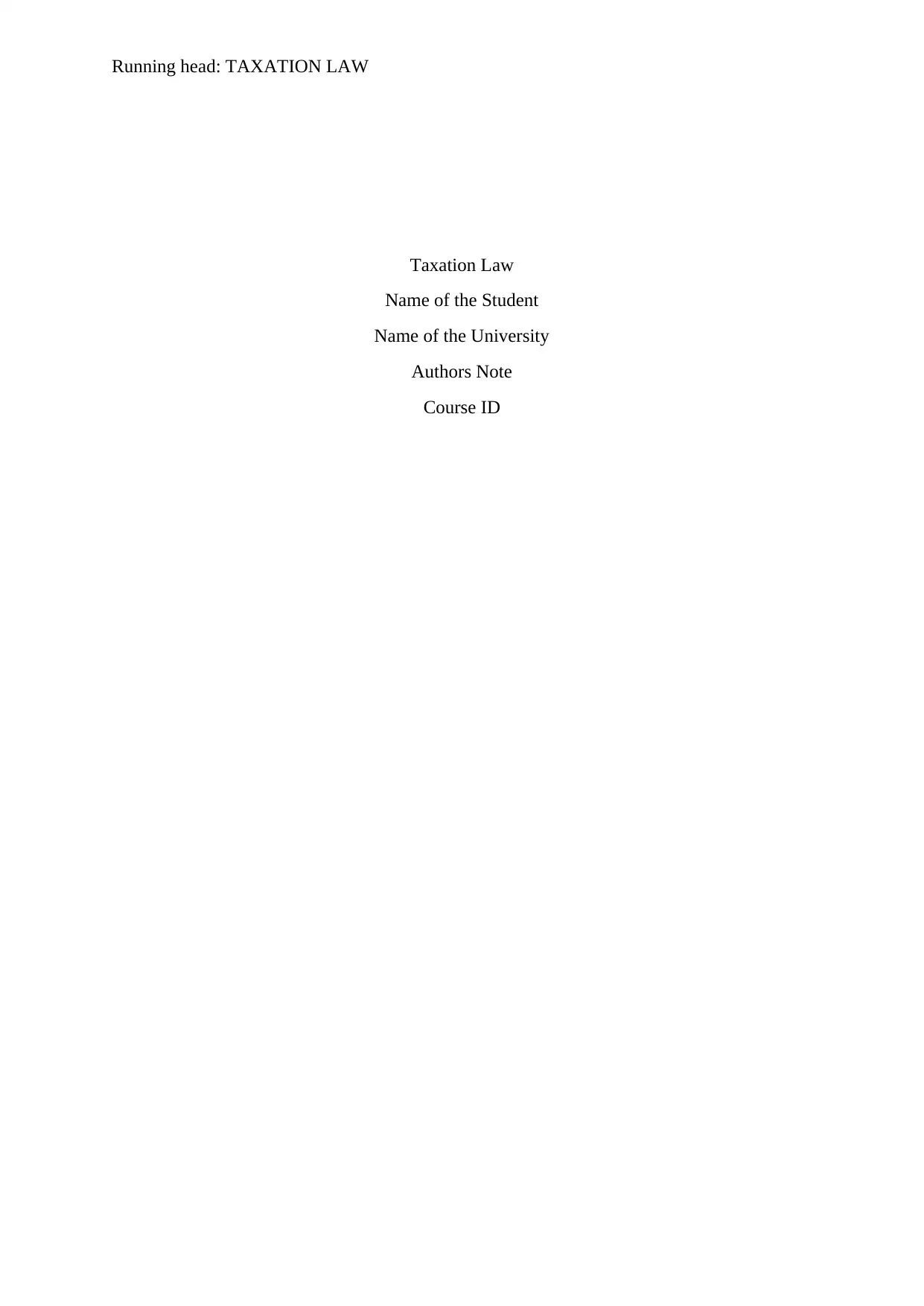
Running head: TAXATION LAW
Taxation Law
Name of the Student
Name of the University
Authors Note
Course ID
Taxation Law
Name of the Student
Name of the University
Authors Note
Course ID
Paraphrase This Document
Need a fresh take? Get an instant paraphrase of this document with our AI Paraphraser
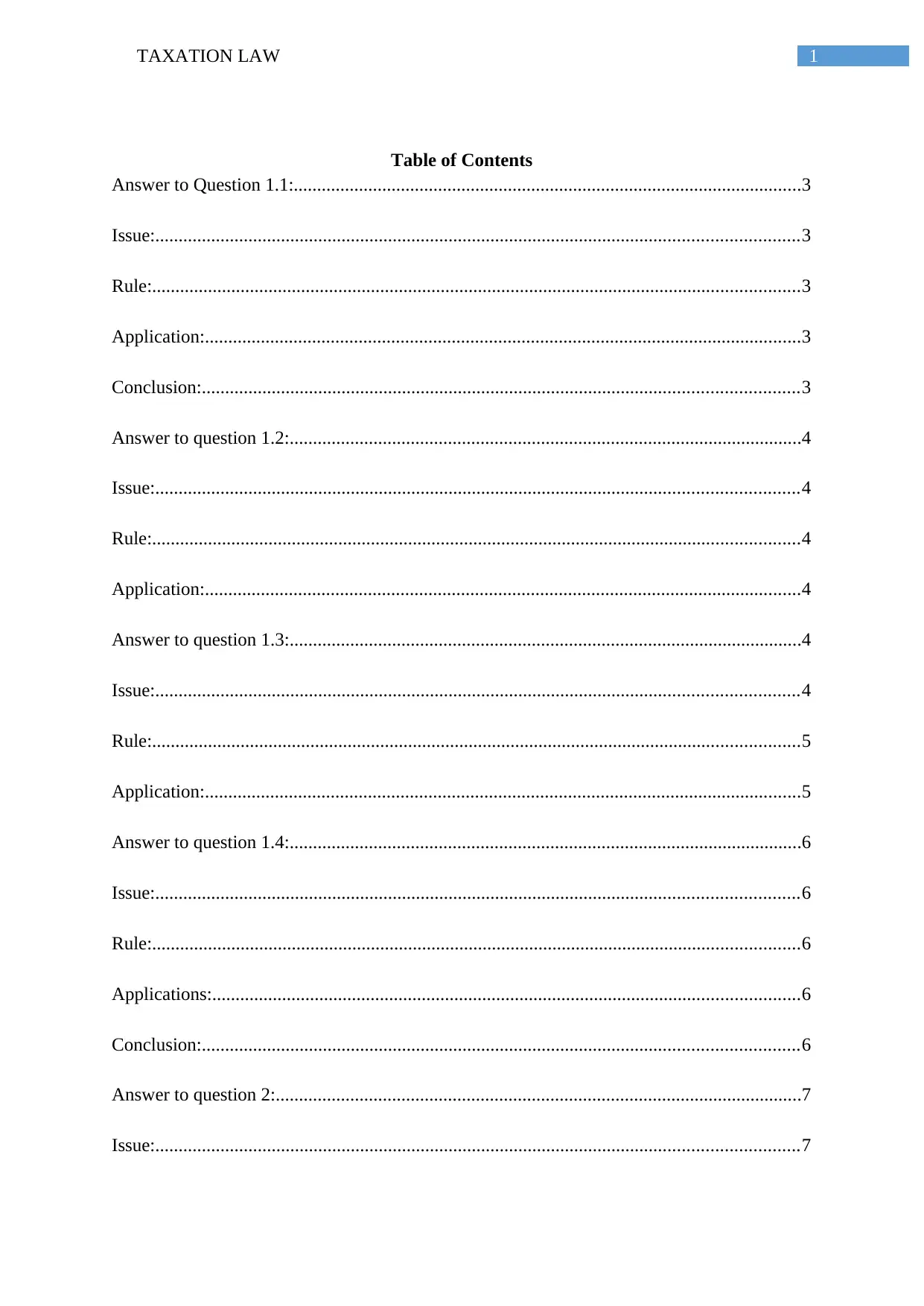
1TAXATION LAW
Table of Contents
Answer to Question 1.1:.............................................................................................................3
Issue:..........................................................................................................................................3
Rule:...........................................................................................................................................3
Application:................................................................................................................................3
Conclusion:................................................................................................................................3
Answer to question 1.2:..............................................................................................................4
Issue:..........................................................................................................................................4
Rule:...........................................................................................................................................4
Application:................................................................................................................................4
Answer to question 1.3:..............................................................................................................4
Issue:..........................................................................................................................................4
Rule:...........................................................................................................................................5
Application:................................................................................................................................5
Answer to question 1.4:..............................................................................................................6
Issue:..........................................................................................................................................6
Rule:...........................................................................................................................................6
Applications:..............................................................................................................................6
Conclusion:................................................................................................................................6
Answer to question 2:.................................................................................................................7
Issue:..........................................................................................................................................7
Table of Contents
Answer to Question 1.1:.............................................................................................................3
Issue:..........................................................................................................................................3
Rule:...........................................................................................................................................3
Application:................................................................................................................................3
Conclusion:................................................................................................................................3
Answer to question 1.2:..............................................................................................................4
Issue:..........................................................................................................................................4
Rule:...........................................................................................................................................4
Application:................................................................................................................................4
Answer to question 1.3:..............................................................................................................4
Issue:..........................................................................................................................................4
Rule:...........................................................................................................................................5
Application:................................................................................................................................5
Answer to question 1.4:..............................................................................................................6
Issue:..........................................................................................................................................6
Rule:...........................................................................................................................................6
Applications:..............................................................................................................................6
Conclusion:................................................................................................................................6
Answer to question 2:.................................................................................................................7
Issue:..........................................................................................................................................7
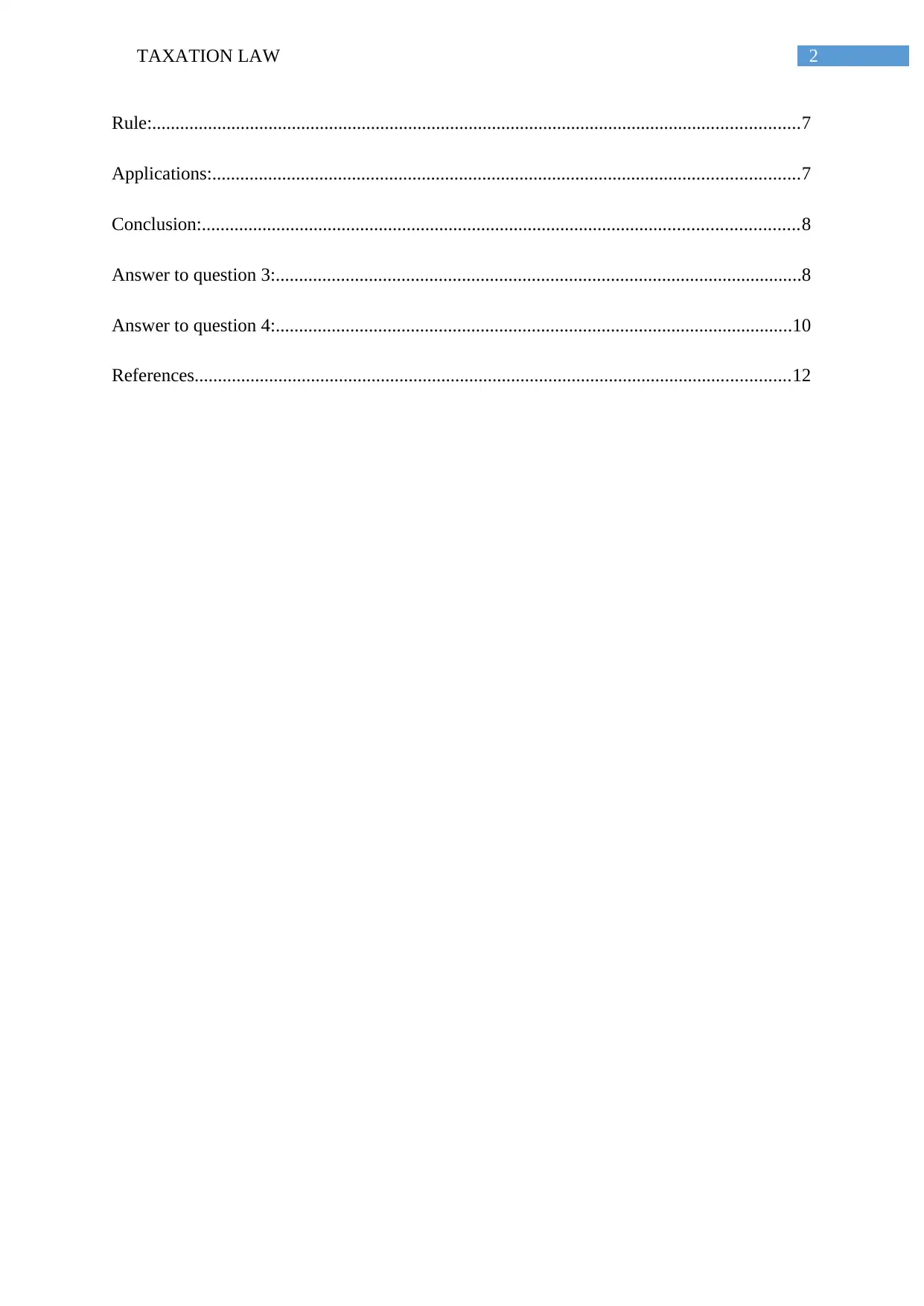
2TAXATION LAW
Rule:...........................................................................................................................................7
Applications:..............................................................................................................................7
Conclusion:................................................................................................................................8
Answer to question 3:.................................................................................................................8
Answer to question 4:...............................................................................................................10
References................................................................................................................................12
Rule:...........................................................................................................................................7
Applications:..............................................................................................................................7
Conclusion:................................................................................................................................8
Answer to question 3:.................................................................................................................8
Answer to question 4:...............................................................................................................10
References................................................................................................................................12
⊘ This is a preview!⊘
Do you want full access?
Subscribe today to unlock all pages.

Trusted by 1+ million students worldwide
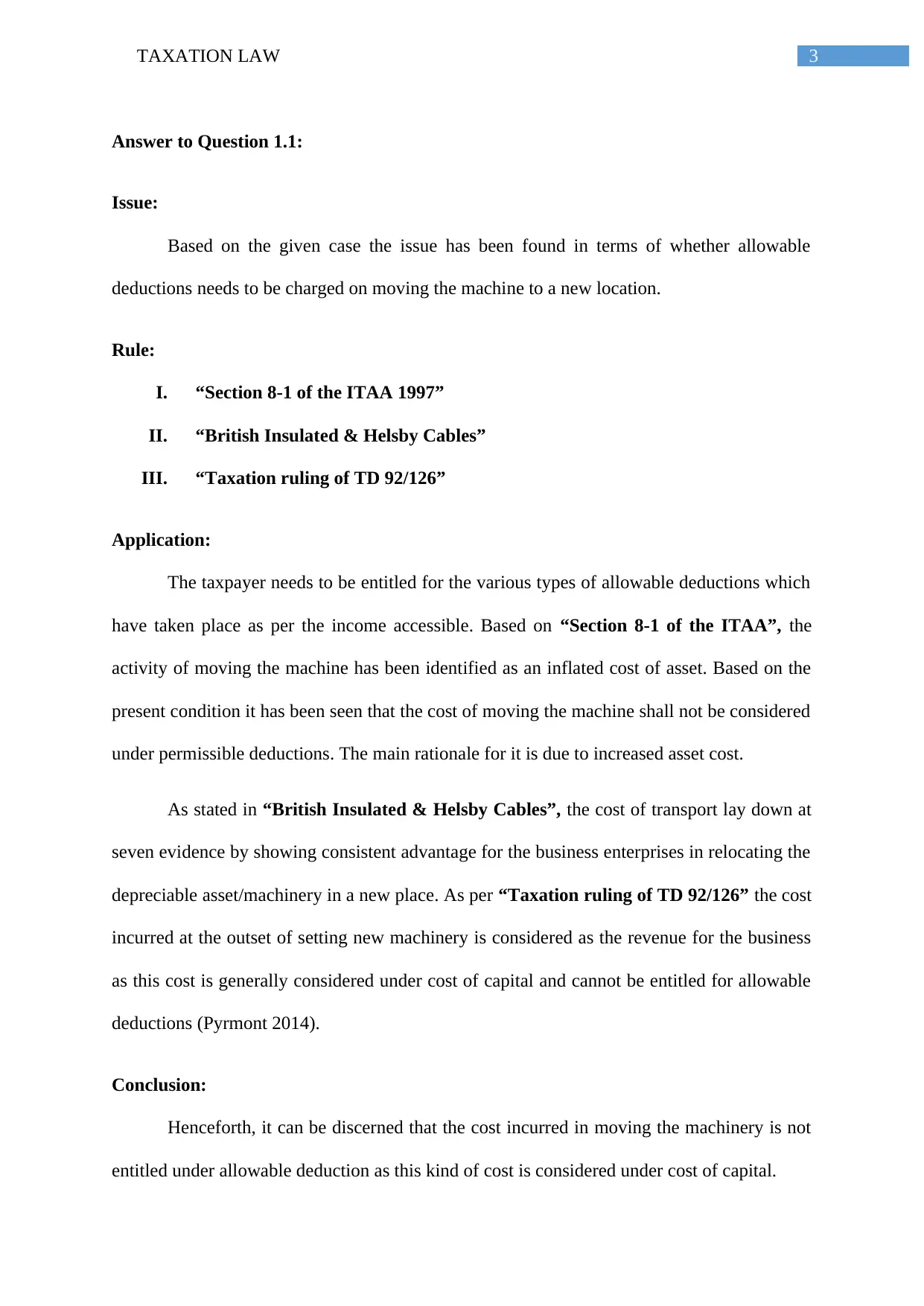
3TAXATION LAW
Answer to Question 1.1:
Issue:
Based on the given case the issue has been found in terms of whether allowable
deductions needs to be charged on moving the machine to a new location.
Rule:
I. “Section 8-1 of the ITAA 1997”
II. “British Insulated & Helsby Cables”
III. “Taxation ruling of TD 92/126”
Application:
The taxpayer needs to be entitled for the various types of allowable deductions which
have taken place as per the income accessible. Based on “Section 8-1 of the ITAA”, the
activity of moving the machine has been identified as an inflated cost of asset. Based on the
present condition it has been seen that the cost of moving the machine shall not be considered
under permissible deductions. The main rationale for it is due to increased asset cost.
As stated in “British Insulated & Helsby Cables”, the cost of transport lay down at
seven evidence by showing consistent advantage for the business enterprises in relocating the
depreciable asset/machinery in a new place. As per “Taxation ruling of TD 92/126” the cost
incurred at the outset of setting new machinery is considered as the revenue for the business
as this cost is generally considered under cost of capital and cannot be entitled for allowable
deductions (Pyrmont 2014).
Conclusion:
Henceforth, it can be discerned that the cost incurred in moving the machinery is not
entitled under allowable deduction as this kind of cost is considered under cost of capital.
Answer to Question 1.1:
Issue:
Based on the given case the issue has been found in terms of whether allowable
deductions needs to be charged on moving the machine to a new location.
Rule:
I. “Section 8-1 of the ITAA 1997”
II. “British Insulated & Helsby Cables”
III. “Taxation ruling of TD 92/126”
Application:
The taxpayer needs to be entitled for the various types of allowable deductions which
have taken place as per the income accessible. Based on “Section 8-1 of the ITAA”, the
activity of moving the machine has been identified as an inflated cost of asset. Based on the
present condition it has been seen that the cost of moving the machine shall not be considered
under permissible deductions. The main rationale for it is due to increased asset cost.
As stated in “British Insulated & Helsby Cables”, the cost of transport lay down at
seven evidence by showing consistent advantage for the business enterprises in relocating the
depreciable asset/machinery in a new place. As per “Taxation ruling of TD 92/126” the cost
incurred at the outset of setting new machinery is considered as the revenue for the business
as this cost is generally considered under cost of capital and cannot be entitled for allowable
deductions (Pyrmont 2014).
Conclusion:
Henceforth, it can be discerned that the cost incurred in moving the machinery is not
entitled under allowable deduction as this kind of cost is considered under cost of capital.
Paraphrase This Document
Need a fresh take? Get an instant paraphrase of this document with our AI Paraphraser
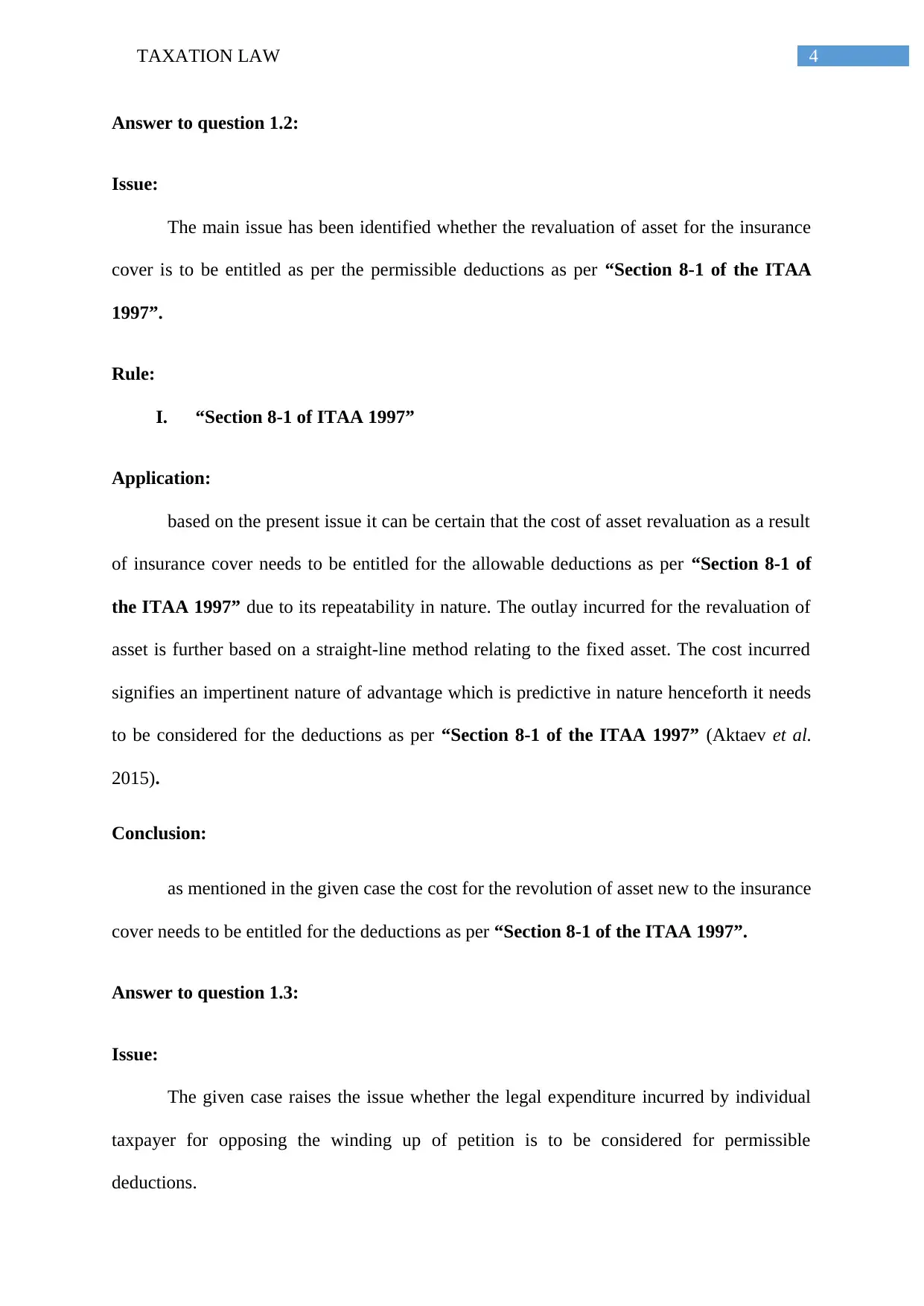
4TAXATION LAW
Answer to question 1.2:
Issue:
The main issue has been identified whether the revaluation of asset for the insurance
cover is to be entitled as per the permissible deductions as per “Section 8-1 of the ITAA
1997”.
Rule:
I. “Section 8-1 of ITAA 1997”
Application:
based on the present issue it can be certain that the cost of asset revaluation as a result
of insurance cover needs to be entitled for the allowable deductions as per “Section 8-1 of
the ITAA 1997” due to its repeatability in nature. The outlay incurred for the revaluation of
asset is further based on a straight-line method relating to the fixed asset. The cost incurred
signifies an impertinent nature of advantage which is predictive in nature henceforth it needs
to be considered for the deductions as per “Section 8-1 of the ITAA 1997” (Aktaev et al.
2015).
Conclusion:
as mentioned in the given case the cost for the revolution of asset new to the insurance
cover needs to be entitled for the deductions as per “Section 8-1 of the ITAA 1997”.
Answer to question 1.3:
Issue:
The given case raises the issue whether the legal expenditure incurred by individual
taxpayer for opposing the winding up of petition is to be considered for permissible
deductions.
Answer to question 1.2:
Issue:
The main issue has been identified whether the revaluation of asset for the insurance
cover is to be entitled as per the permissible deductions as per “Section 8-1 of the ITAA
1997”.
Rule:
I. “Section 8-1 of ITAA 1997”
Application:
based on the present issue it can be certain that the cost of asset revaluation as a result
of insurance cover needs to be entitled for the allowable deductions as per “Section 8-1 of
the ITAA 1997” due to its repeatability in nature. The outlay incurred for the revaluation of
asset is further based on a straight-line method relating to the fixed asset. The cost incurred
signifies an impertinent nature of advantage which is predictive in nature henceforth it needs
to be considered for the deductions as per “Section 8-1 of the ITAA 1997” (Aktaev et al.
2015).
Conclusion:
as mentioned in the given case the cost for the revolution of asset new to the insurance
cover needs to be entitled for the deductions as per “Section 8-1 of the ITAA 1997”.
Answer to question 1.3:
Issue:
The given case raises the issue whether the legal expenditure incurred by individual
taxpayer for opposing the winding up of petition is to be considered for permissible
deductions.
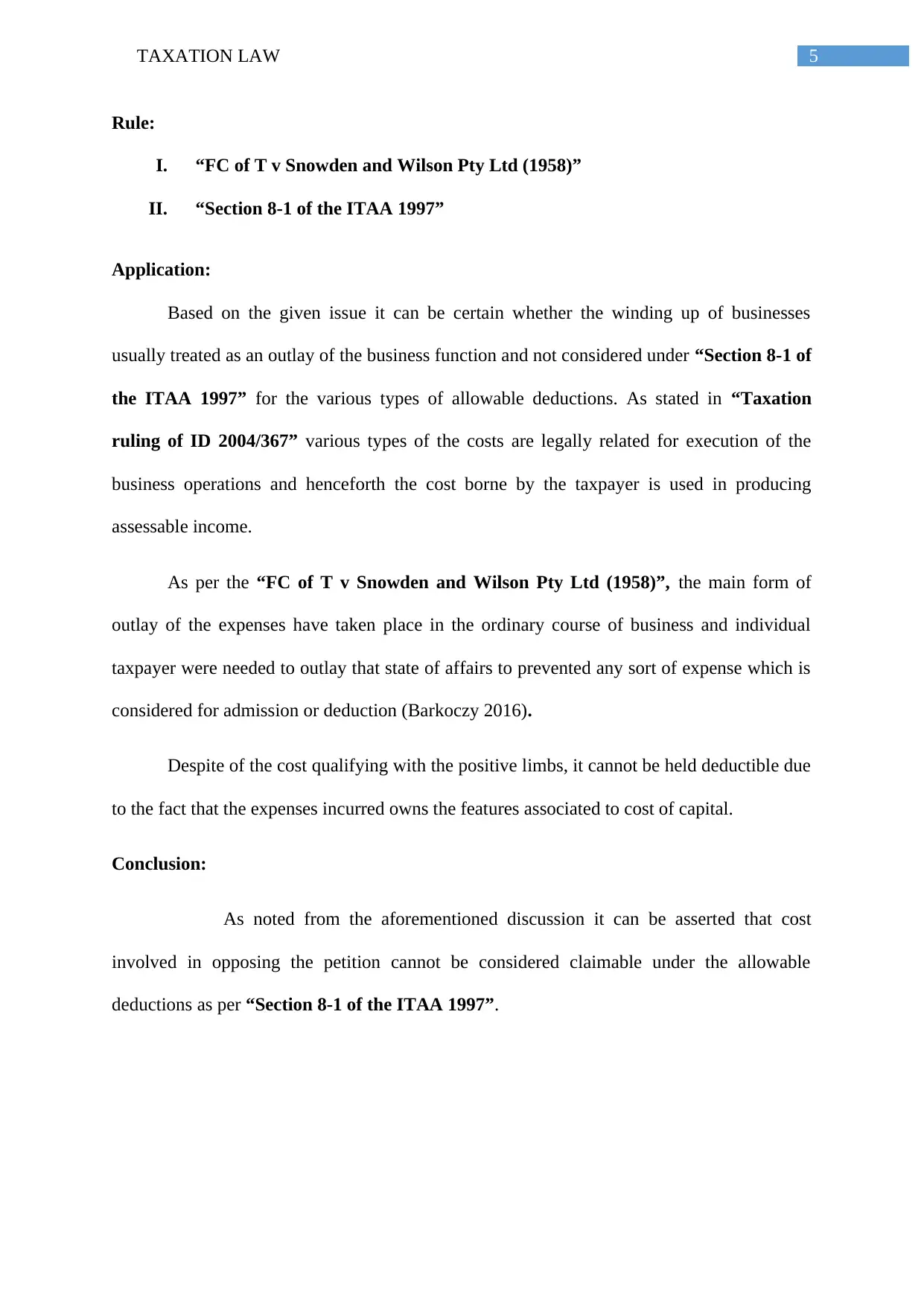
5TAXATION LAW
Rule:
I. “FC of T v Snowden and Wilson Pty Ltd (1958)”
II. “Section 8-1 of the ITAA 1997”
Application:
Based on the given issue it can be certain whether the winding up of businesses
usually treated as an outlay of the business function and not considered under “Section 8-1 of
the ITAA 1997” for the various types of allowable deductions. As stated in “Taxation
ruling of ID 2004/367” various types of the costs are legally related for execution of the
business operations and henceforth the cost borne by the taxpayer is used in producing
assessable income.
As per the “FC of T v Snowden and Wilson Pty Ltd (1958)”, the main form of
outlay of the expenses have taken place in the ordinary course of business and individual
taxpayer were needed to outlay that state of affairs to prevented any sort of expense which is
considered for admission or deduction (Barkoczy 2016).
Despite of the cost qualifying with the positive limbs, it cannot be held deductible due
to the fact that the expenses incurred owns the features associated to cost of capital.
Conclusion:
As noted from the aforementioned discussion it can be asserted that cost
involved in opposing the petition cannot be considered claimable under the allowable
deductions as per “Section 8-1 of the ITAA 1997”.
Rule:
I. “FC of T v Snowden and Wilson Pty Ltd (1958)”
II. “Section 8-1 of the ITAA 1997”
Application:
Based on the given issue it can be certain whether the winding up of businesses
usually treated as an outlay of the business function and not considered under “Section 8-1 of
the ITAA 1997” for the various types of allowable deductions. As stated in “Taxation
ruling of ID 2004/367” various types of the costs are legally related for execution of the
business operations and henceforth the cost borne by the taxpayer is used in producing
assessable income.
As per the “FC of T v Snowden and Wilson Pty Ltd (1958)”, the main form of
outlay of the expenses have taken place in the ordinary course of business and individual
taxpayer were needed to outlay that state of affairs to prevented any sort of expense which is
considered for admission or deduction (Barkoczy 2016).
Despite of the cost qualifying with the positive limbs, it cannot be held deductible due
to the fact that the expenses incurred owns the features associated to cost of capital.
Conclusion:
As noted from the aforementioned discussion it can be asserted that cost
involved in opposing the petition cannot be considered claimable under the allowable
deductions as per “Section 8-1 of the ITAA 1997”.
⊘ This is a preview!⊘
Do you want full access?
Subscribe today to unlock all pages.

Trusted by 1+ million students worldwide
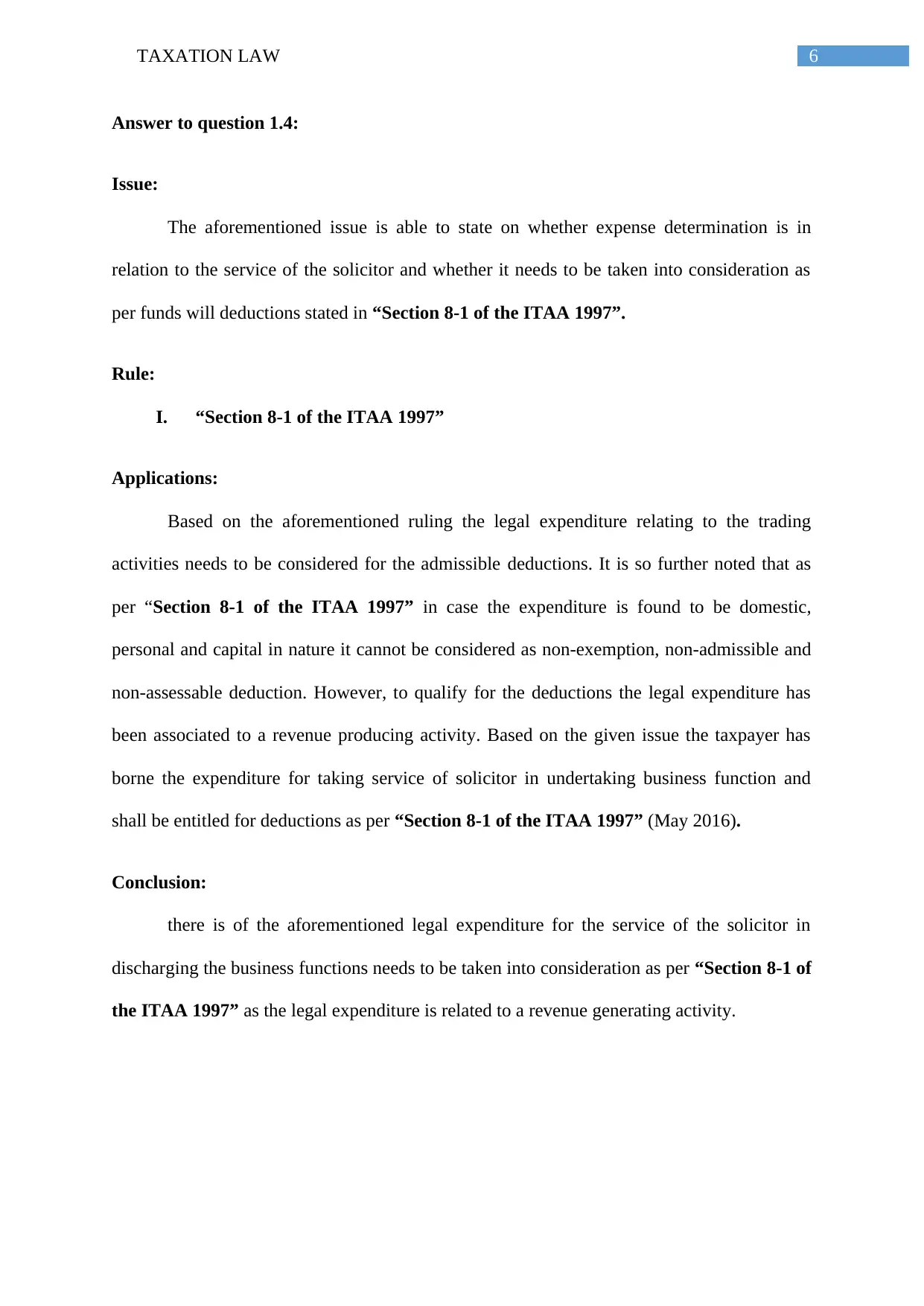
6TAXATION LAW
Answer to question 1.4:
Issue:
The aforementioned issue is able to state on whether expense determination is in
relation to the service of the solicitor and whether it needs to be taken into consideration as
per funds will deductions stated in “Section 8-1 of the ITAA 1997”.
Rule:
I. “Section 8-1 of the ITAA 1997”
Applications:
Based on the aforementioned ruling the legal expenditure relating to the trading
activities needs to be considered for the admissible deductions. It is so further noted that as
per “Section 8-1 of the ITAA 1997” in case the expenditure is found to be domestic,
personal and capital in nature it cannot be considered as non-exemption, non-admissible and
non-assessable deduction. However, to qualify for the deductions the legal expenditure has
been associated to a revenue producing activity. Based on the given issue the taxpayer has
borne the expenditure for taking service of solicitor in undertaking business function and
shall be entitled for deductions as per “Section 8-1 of the ITAA 1997” (May 2016).
Conclusion:
there is of the aforementioned legal expenditure for the service of the solicitor in
discharging the business functions needs to be taken into consideration as per “Section 8-1 of
the ITAA 1997” as the legal expenditure is related to a revenue generating activity.
Answer to question 1.4:
Issue:
The aforementioned issue is able to state on whether expense determination is in
relation to the service of the solicitor and whether it needs to be taken into consideration as
per funds will deductions stated in “Section 8-1 of the ITAA 1997”.
Rule:
I. “Section 8-1 of the ITAA 1997”
Applications:
Based on the aforementioned ruling the legal expenditure relating to the trading
activities needs to be considered for the admissible deductions. It is so further noted that as
per “Section 8-1 of the ITAA 1997” in case the expenditure is found to be domestic,
personal and capital in nature it cannot be considered as non-exemption, non-admissible and
non-assessable deduction. However, to qualify for the deductions the legal expenditure has
been associated to a revenue producing activity. Based on the given issue the taxpayer has
borne the expenditure for taking service of solicitor in undertaking business function and
shall be entitled for deductions as per “Section 8-1 of the ITAA 1997” (May 2016).
Conclusion:
there is of the aforementioned legal expenditure for the service of the solicitor in
discharging the business functions needs to be taken into consideration as per “Section 8-1 of
the ITAA 1997” as the legal expenditure is related to a revenue generating activity.
Paraphrase This Document
Need a fresh take? Get an instant paraphrase of this document with our AI Paraphraser
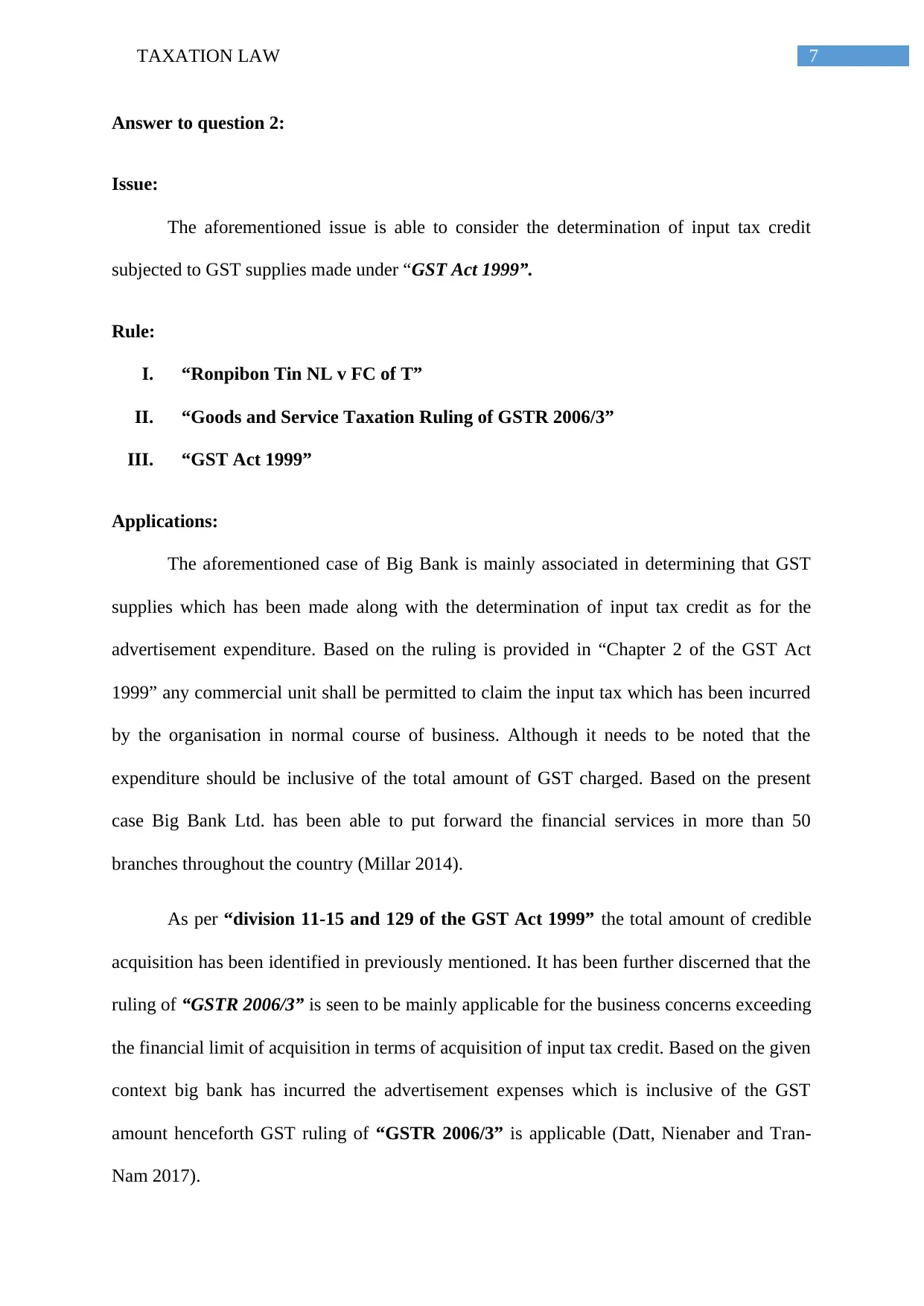
7TAXATION LAW
Answer to question 2:
Issue:
The aforementioned issue is able to consider the determination of input tax credit
subjected to GST supplies made under “GST Act 1999”.
Rule:
I. “Ronpibon Tin NL v FC of T”
II. “Goods and Service Taxation Ruling of GSTR 2006/3”
III. “GST Act 1999”
Applications:
The aforementioned case of Big Bank is mainly associated in determining that GST
supplies which has been made along with the determination of input tax credit as for the
advertisement expenditure. Based on the ruling is provided in “Chapter 2 of the GST Act
1999” any commercial unit shall be permitted to claim the input tax which has been incurred
by the organisation in normal course of business. Although it needs to be noted that the
expenditure should be inclusive of the total amount of GST charged. Based on the present
case Big Bank Ltd. has been able to put forward the financial services in more than 50
branches throughout the country (Millar 2014).
As per “division 11-15 and 129 of the GST Act 1999” the total amount of credible
acquisition has been identified in previously mentioned. It has been further discerned that the
ruling of “GSTR 2006/3” is seen to be mainly applicable for the business concerns exceeding
the financial limit of acquisition in terms of acquisition of input tax credit. Based on the given
context big bank has incurred the advertisement expenses which is inclusive of the GST
amount henceforth GST ruling of “GSTR 2006/3” is applicable (Datt, Nienaber and Tran-
Nam 2017).
Answer to question 2:
Issue:
The aforementioned issue is able to consider the determination of input tax credit
subjected to GST supplies made under “GST Act 1999”.
Rule:
I. “Ronpibon Tin NL v FC of T”
II. “Goods and Service Taxation Ruling of GSTR 2006/3”
III. “GST Act 1999”
Applications:
The aforementioned case of Big Bank is mainly associated in determining that GST
supplies which has been made along with the determination of input tax credit as for the
advertisement expenditure. Based on the ruling is provided in “Chapter 2 of the GST Act
1999” any commercial unit shall be permitted to claim the input tax which has been incurred
by the organisation in normal course of business. Although it needs to be noted that the
expenditure should be inclusive of the total amount of GST charged. Based on the present
case Big Bank Ltd. has been able to put forward the financial services in more than 50
branches throughout the country (Millar 2014).
As per “division 11-15 and 129 of the GST Act 1999” the total amount of credible
acquisition has been identified in previously mentioned. It has been further discerned that the
ruling of “GSTR 2006/3” is seen to be mainly applicable for the business concerns exceeding
the financial limit of acquisition in terms of acquisition of input tax credit. Based on the given
context big bank has incurred the advertisement expenses which is inclusive of the GST
amount henceforth GST ruling of “GSTR 2006/3” is applicable (Datt, Nienaber and Tran-
Nam 2017).
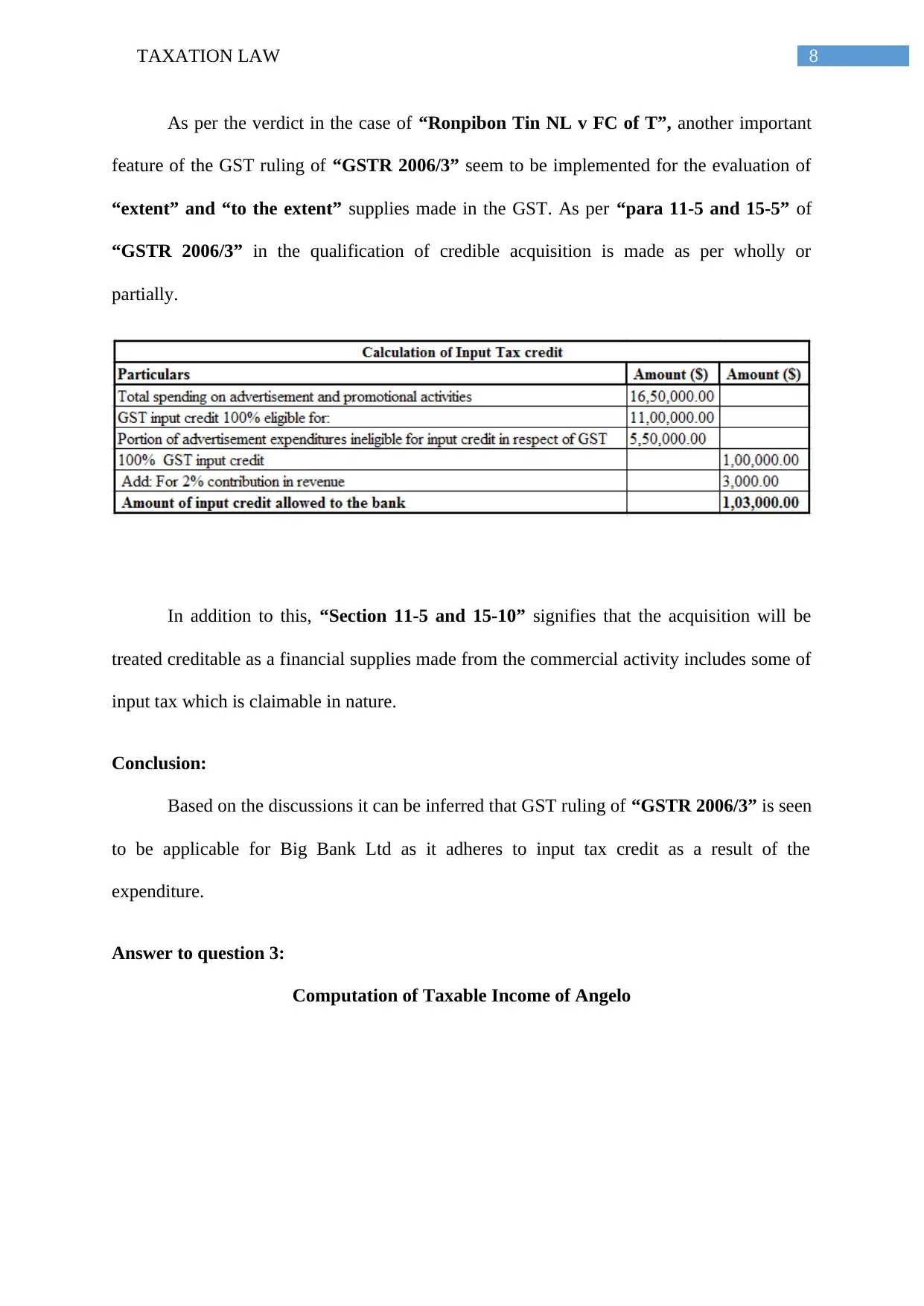
8TAXATION LAW
As per the verdict in the case of “Ronpibon Tin NL v FC of T”, another important
feature of the GST ruling of “GSTR 2006/3” seem to be implemented for the evaluation of
“extent” and “to the extent” supplies made in the GST. As per “para 11-5 and 15-5” of
“GSTR 2006/3” in the qualification of credible acquisition is made as per wholly or
partially.
In addition to this, “Section 11-5 and 15-10” signifies that the acquisition will be
treated creditable as a financial supplies made from the commercial activity includes some of
input tax which is claimable in nature.
Conclusion:
Based on the discussions it can be inferred that GST ruling of “GSTR 2006/3” is seen
to be applicable for Big Bank Ltd as it adheres to input tax credit as a result of the
expenditure.
Answer to question 3:
Computation of Taxable Income of Angelo
As per the verdict in the case of “Ronpibon Tin NL v FC of T”, another important
feature of the GST ruling of “GSTR 2006/3” seem to be implemented for the evaluation of
“extent” and “to the extent” supplies made in the GST. As per “para 11-5 and 15-5” of
“GSTR 2006/3” in the qualification of credible acquisition is made as per wholly or
partially.
In addition to this, “Section 11-5 and 15-10” signifies that the acquisition will be
treated creditable as a financial supplies made from the commercial activity includes some of
input tax which is claimable in nature.
Conclusion:
Based on the discussions it can be inferred that GST ruling of “GSTR 2006/3” is seen
to be applicable for Big Bank Ltd as it adheres to input tax credit as a result of the
expenditure.
Answer to question 3:
Computation of Taxable Income of Angelo
⊘ This is a preview!⊘
Do you want full access?
Subscribe today to unlock all pages.

Trusted by 1+ million students worldwide
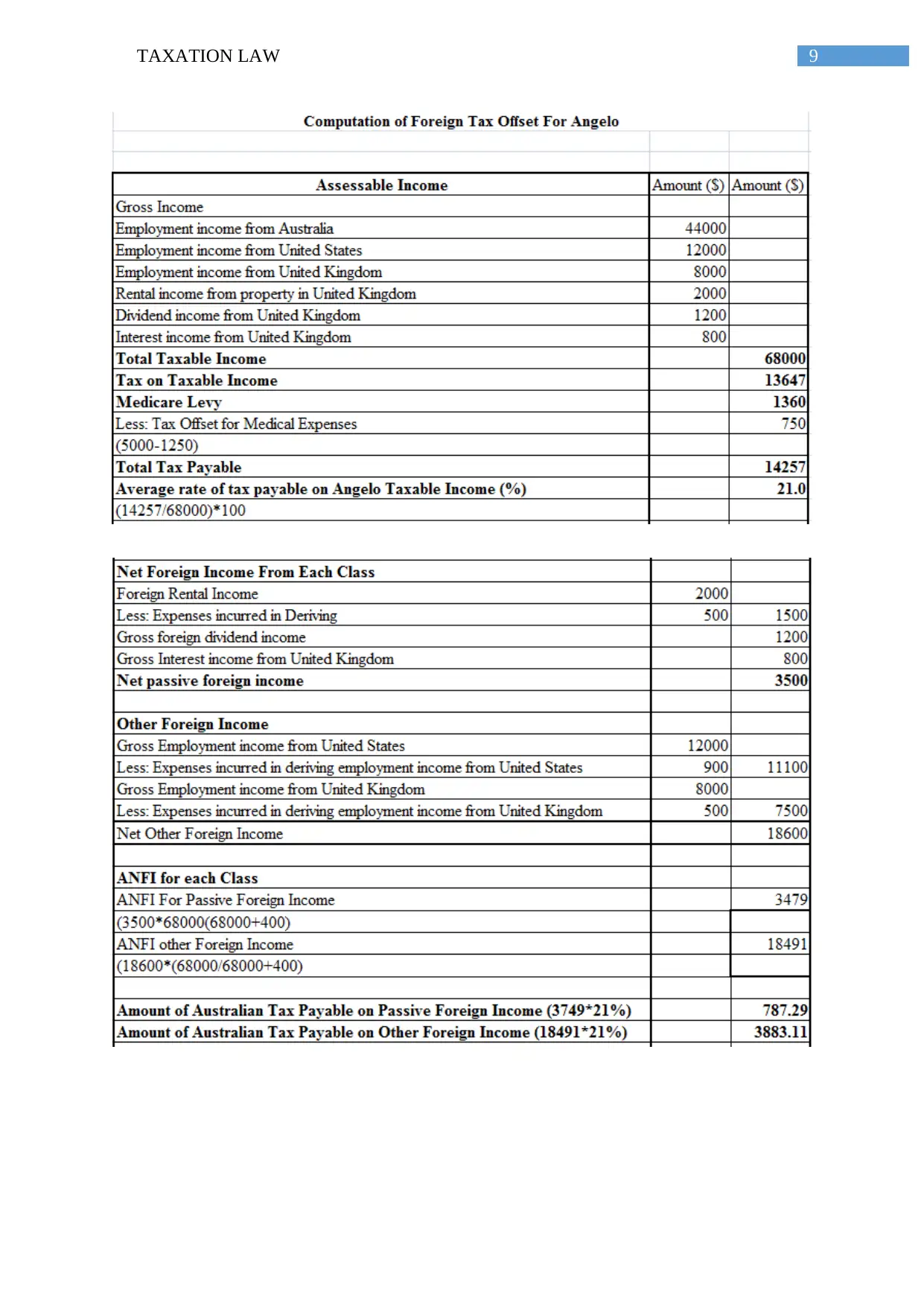
9TAXATION LAW
Paraphrase This Document
Need a fresh take? Get an instant paraphrase of this document with our AI Paraphraser
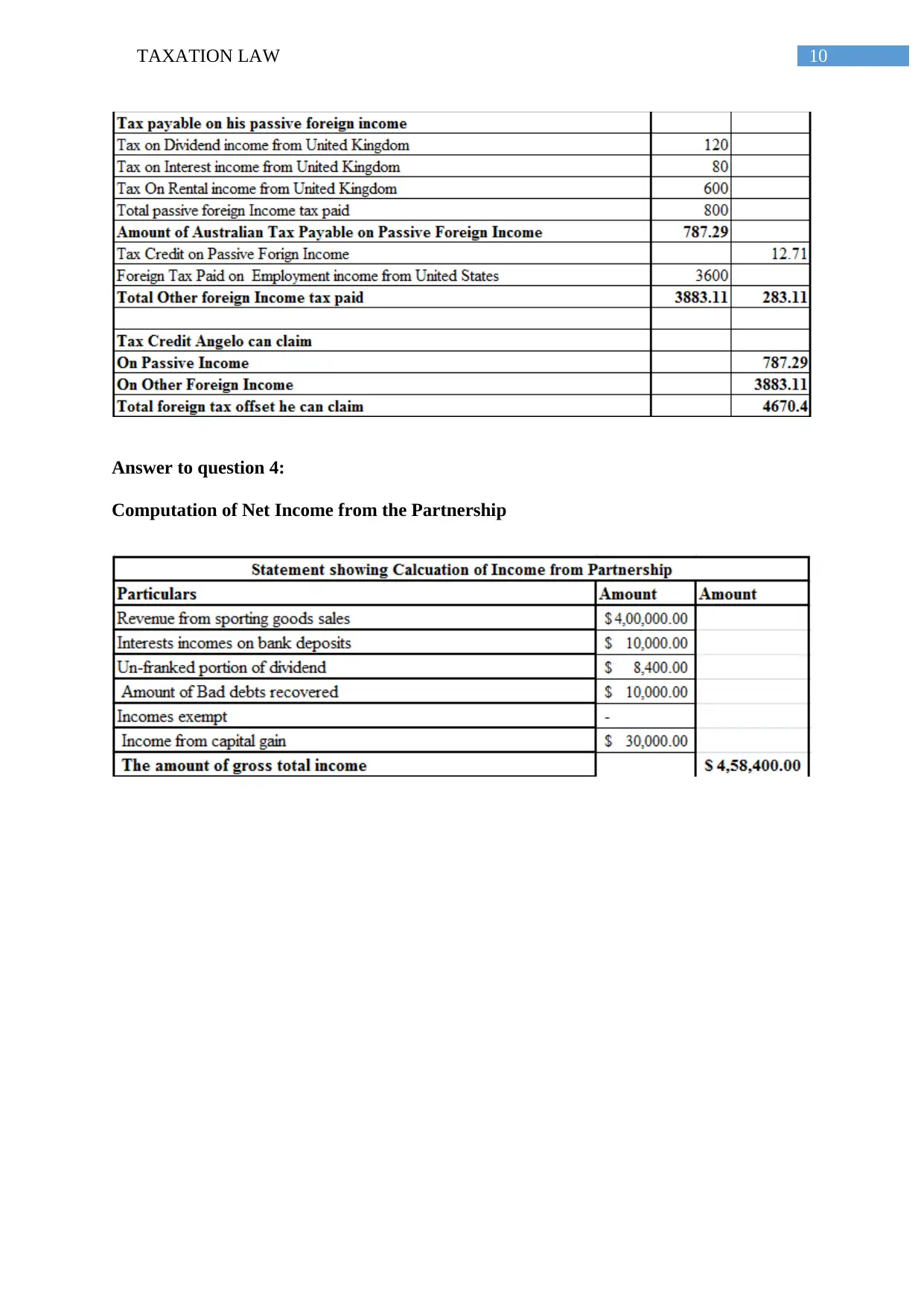
10TAXATION LAW
Answer to question 4:
Computation of Net Income from the Partnership
Answer to question 4:
Computation of Net Income from the Partnership
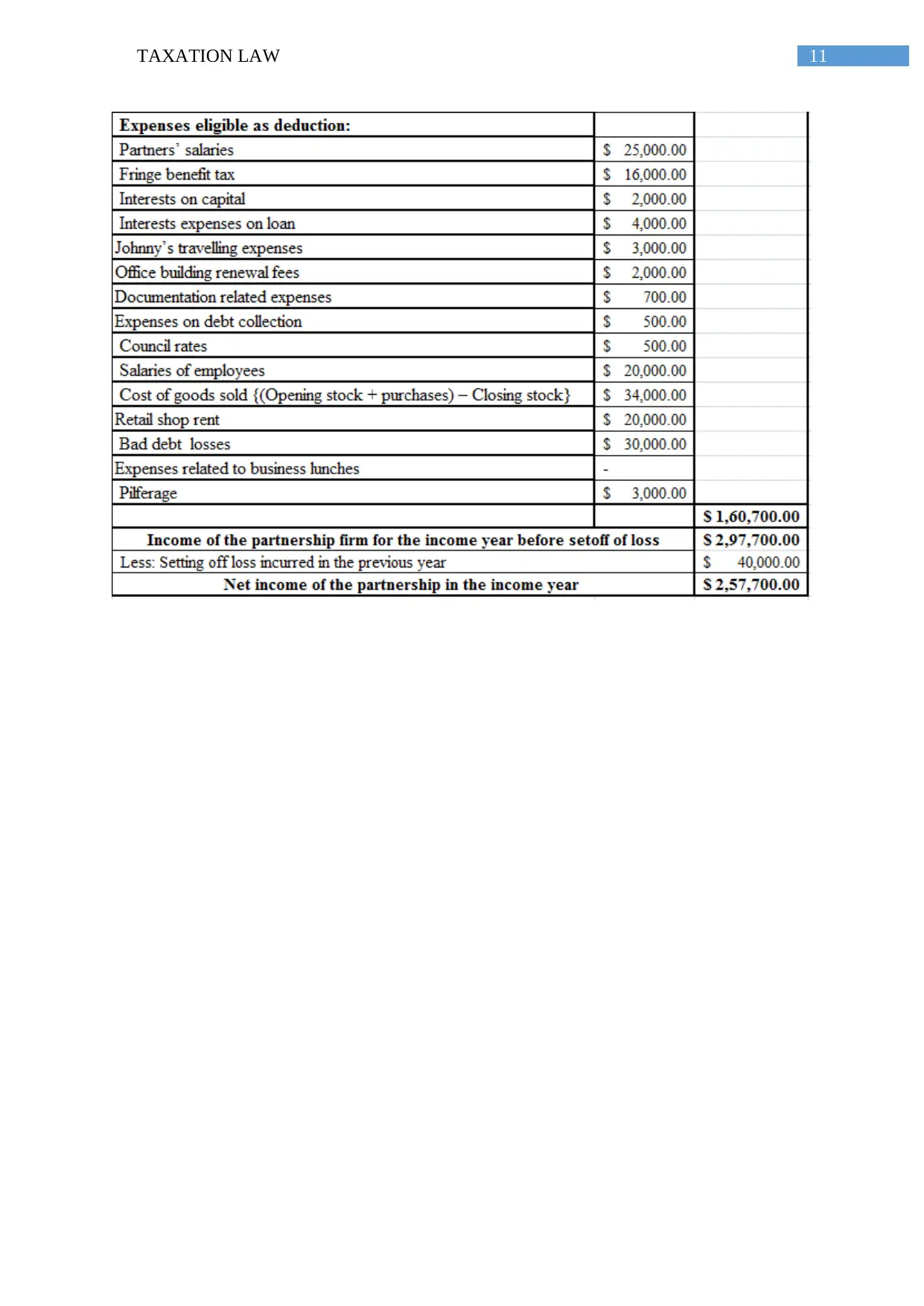
11TAXATION LAW
⊘ This is a preview!⊘
Do you want full access?
Subscribe today to unlock all pages.

Trusted by 1+ million students worldwide
1 out of 13
Related Documents
Your All-in-One AI-Powered Toolkit for Academic Success.
+13062052269
info@desklib.com
Available 24*7 on WhatsApp / Email
![[object Object]](/_next/static/media/star-bottom.7253800d.svg)
Unlock your academic potential
Copyright © 2020–2025 A2Z Services. All Rights Reserved. Developed and managed by ZUCOL.





